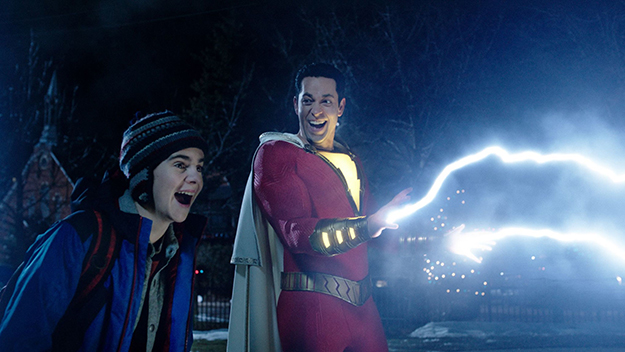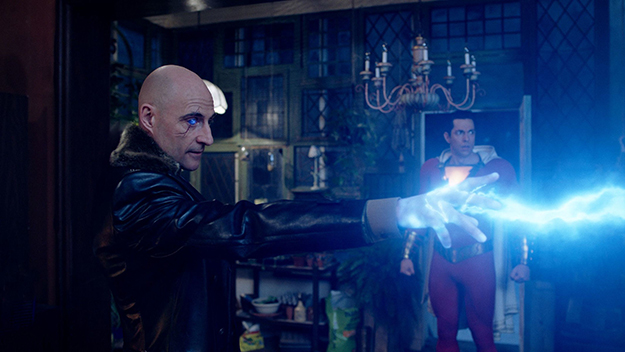Deep Focus: Shazam!

All images from Shazam! (David F. Sandberg, 2019)
The magic word that turns 14-year-old Billy Batson into a superman, shazam, is an acronym summarizing his powers: the wisdom of Solomon, the strength of Hercules, the stamina of Atlas, the power of Zeus, the courage of Achilles, and the speed of Mercury. David F. Sandberg’s nifty, exuberant Shazam! might have snuck in a third A for the joy-giving qualities of Aphrodite and a second M for the satirical humor of Momus. As the drawling Gomer Pyle used to exclaim, “SHAAZAMM!”
Written by Henry Gayden, from a story by Gayden and Darren Lemke, this film melds the unpretentious, dreamy joys of old-time comic books with the sly, rambunctious humor of Rocky and Bullwinkle cartoon featurettes like “Fractured Fairy Tales” and “Aesop and Son.” It takes its lost-boy protagonist Billy (Asher Angel), who’s been searching for his biological mother since age three, just seriously enough. We care about whether he’ll stick with his latest and best foster home, hip guardians Rosa and Victor Vasquez (Marta Milans and Cooper Andrews), and genial foster siblings, notably superhero aficionado Freddy Freeman (Jack Dylan Grazer), who spins tall tales about why he walks with a forearm crutch, and doesn’t let anything slow him down.
The young performers—from Faithe Herman as little Darla Dudley, who yearns for Billy to treat her like a real sister, to Grace Fulton as college-bound Mary Bromfield, who only looks as if she’s all business—stay loose and limber. Given the Philly setting and the movie’s theme, I kept waiting to hear Sister Sledge sing “We Are Family,” and watch this happy cast frug to it.
The script places them in a stylized, funky, mostly comedic context that keeps the emotions from getting sloppy and the mayhem from descending into destruction porn. For once we have an origin story that plays more like a rounded fable. It hinges on a wizard (Djimon Hounsou) searching for a “champion” who is “strong of spirit and pure of heart.” In its own cheerful adolescent terms, it’s emotionally complete.
As Shazam, Zachary Levi gives a wonderfully elastic, oversized performance. Thanks to Levi, Billy’s physical transformation from a crazy, mixed-up 14-year-old into a thirtysomething super-superhero has a kid-in-a-candy-store quality. His satisfaction is infectious when he and Grazer’s Freddy, after halting a convenience store stickup and proving that Shazam can stop bullets with his face, fill their arms with all the junk snacks they can carry.
The movie unfolds in lower-middle-class Philadelphia (cunningly replicated in Toronto), now America’s sixth-largest city. With its connection to our country’s favorite underdog, Rocky, it provides the ideal scale and ambiance for a hero who saves the world by going the distance for his pals. It also supplies the underlying metaphor—Shazam preserves a City of Brotherly (and Sisterly) Love.

The plot parallels Billy’s pulp odyssey and that of the arch-villain, Dr. Thaddeus Sivana (Mark Strong). Billy has kept trying to find his way home to his mother: he holds onto a tiny compass globe she won for him minutes before he got lost in a carnival crowd. He eventually learns that blood alone won’t determine what makes a place a home. Meanwhile, the mad scientist Sivana, inspired by his 1970s Magic 8 Ball toy, has searched relentlessly for the regal cave that houses the Rock of Destiny, where Hounsou’s wizard summoned him as a child. (It’s in an alternate dimension.) Sivana failed then to become his champion, since he was susceptible to the Seven Deadly Sins the wizard had encased in rocky gargoyles. Roughly 45 years later, the ever-weakening wizard, desperate to find a standard-bearer for virtue, decides that Billy is The One. It’s no goody-goody choice. Billy has escaped from homes in six Pennsylvania counties and engaged in petty crimes to further his quest. But he grows as a person inside his semi-ridiculous scarlet super-suit, with its lightning-bolt chest plate and layered white cape.
Sivana, on the other hand, becomes the champion of the Seven Deadly Sins. He destroys what’s left of his own admittedly hideous family, then demands that Shazam bequeath his superpowers to him. Though inside, Shazam really is a boy on a man’s job, not yet adept at ultra-martial artistry, he never gives in to Sivana and his Seven Sins. But the film doesn’t devolve into over-scaled wrestling and mayhem. Shazam gets by with a little help from his friends. They’re part geek chorus, part a smarter, updated, multiracial, and coed version of Fat Albert’s gang.
Fact check: no one in the film actually calls Billy’s alter ego “Shazam.” He and Freddy run through a checklist of daredevil superpowers, including the ability to shoot electric currents from his fingertips (he uses it to recharge passersby’s cellphones), as they try out various names, like “Captain Sparklefingers” or “Thundercrack,” which they reject for sounding like a butt joke, or “Mr. Philadelphia,” which they deem too cream-cheesy.
The figure presented to us here as Shazam was born “Captain Marvel” in 1940, a blatant Superman knock-off who soon outsold the Man of Steel himself. As Jules Feiffer explains in his introduction to The Great Comic Book Heroes (1965), a superb work of personal pop criticism, “Superman was far too puritanical: if you didn’t come from his planet you couldn’t ever be super—that was that. But the more liberal Captain Marvel left the door open. His method of becoming super was the simplest of all—no solar systems or test tubes involved—all that was needed was a magic word: ‘Shazam!’” Captain Marvel’s success made him the first superhero in a movie serial, the slam-bang The Adventures of Captain Marvel (1941). His popularity catalyzed a lawsuit: Superman’s publishers painted him as a carbon copy. As the suit dragged on, the sales king lost his luster, and then the case, and ultimately, his name. Marvel Comics created its own, unrelated Captain Marvel, and in his later reincarnations, Superman’s own publisher, DC, which had acquired rights to the 1940s’ character, labeled him Shazam. The magic word became his destiny, and his identity.
Feiffer’s introduction must have influenced the tenor of the Shazam! movie as much as any recent run of the comic book. Feiffer writes that the original “was gifted with the light touch.” Just as it was drawn in a skillful, deceptively “easy” style, the movie keeps its effects relatively simple, too. The gargoyle Sins don’t really imitate human conversation, they merely speak their thoughts with their mouths open. They and Sivana come and go in soot-storms a small step up from the chimney debris in Mary Poppins movies. Even my favorite sight gag—humanoid crocodiles imitating “Dogs Playing Poker”—makes do with three reptiles instead of seven canines. The charming Shazam-related effects work partly because of his early foibles, such as not quite leaping a tall building in a single bound, and partly because of his later propensity for teamwork. The result is what Feiffer called “A Disneyland of happy violence.” Like the first Captain Marvel, Levi’s Shazam has a “Fred MacMurray look,” and “could be imagined being a buddy rather than a hero, an overgrown boy who chased villains as if they were squirrels. A perfect fantasy figure for, say, Charlie Brown.” Feiffer says he soured on the original even before he learned of the lawsuit: “More and more his adventures took on the tone of parodies—item: Billy Batson being turned into a baby by mad scientist Dr. Sivana and thus not being able to say the magic word, it coming out ‘Tha-tham!’ I was not prepared for frivolousness on the part of my super-heroes!”
The success of movies like Shazam!, the exhilarating seriocomedy Spider-Man: Into the Spider-Verse, the lowdown, witty Deadpool series, and the gloriously campy Thor: Ragnarok proves that after decades of portentous superhero movies, we’re not just prepared for frivolousness: we’re hungry for it.
Michael Sragow is a contributing editor to Film Comment and writes its Deep Focus column. He is a member of the National Society of Film Critics and the Los Angeles Film Critics Association.







